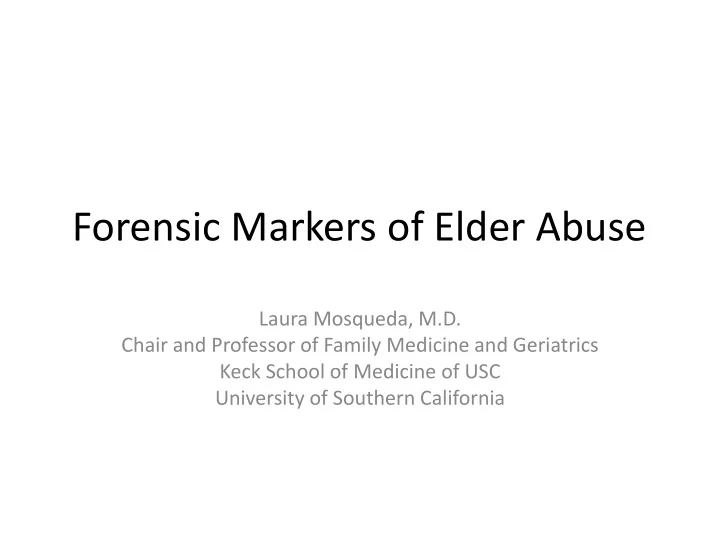

Forensic Markers of Elder Abuse Laura Mosqueda, M.D. Chair and Professor of Family Medicine and Geriatrics Keck School of Medicine of USC University of Southern California
The Game Plan • Introductory comments • Age-related changes and how they relate to markers of abuse/neglect • Markers of abuse/neglect • Closing thoughts • Questions (as we go and at the end), moderated by the NAPSA team – As we go: to clarify, challenge, correct – At the end: to discuss, bring up new points
Why is it important to understand forensic markers of abuse and neglect? • “Old people just bruise easily.” • “Old people are dirty.” • “It’s a shame, but lots of old people die with bedsores and in pretty filthy condition.”
What the heck is going on?!
Aging is accompanied by changes that make us susceptible to physical and emotional injury. These changes often make it hard to diagnose abuse/neglect.
Common and normal age-related changes mask and mimic signs of elder mistreatment. You won’t find it if you don’t: • Know it exists • Look for it • Recognize it when you see it
Why is it sometimes difficult to distinguish when a sore or injury is due to benign reasons vs due to abuse or neglect?
Usual and Common Changes • Musculoskeletal system (bone density) • Neurologic system (reaction time, memory) • Integument (thinner skin, capillary fragility) • Renal: Decrease in creatinine clearance • Sensory (poor hearing, cataracts) • Consequences …..
Consequences of These Changes • Greater susceptibility to illness • More difficulty in recovering from illness • Sensitivity to side effects of medication • Vulnerability to abuse • More difficult to diagnose abuse
The Challenge in Diagnosing Abuse • Changes with aging • Multiple co-morbidities • Medication effects • Cognitive impairment
Potential Markers Types of Injuries What I look for • Bruises • Location • Pressure sores • Fractures • Old injuries • Burns • Delay in seeking care • History & exam consistent?
History and Observations • Implausible/vague explanations • Delay in seeking care • Unexplained injuries - past or present • Interaction between patient and caregiver
Physical Abuse and Neglect: Clues, Markers • Sores, bruises, other wounds • Unkempt appearance • Poor hygiene • Malnutrition • Dehydration
Physical Abuse and Neglect: Clues, Markers • Sores , bruises , other wounds • Unkempt appearance • Poor hygiene • Malnutrition • Dehydration
Pressure Sores • Causes – Pressure – Friction – Shearing – Moisture • Stages – (I-IV) – Unstageable • Suspected Deep Tissue Injury
Pressure Sores: Contributing Factors • Nutritional status – Able to get own food? – Able to feed self? • Mobility status – Never moved – Tied down in one position
Concerning factors • Lack of appropriate measures to prevent, treat, or ameliorate • Extreme – Malodor – Exudate (pus) – Size – Depth – Number • Location
Anterior Comparison Part I: Accidental Part II: Physical Abuse
Posterior Comparison Part I: Accidental Part II: Physical Abuse
Accidental or Inflicted?
These are tough issues and we need to be cautious. • Don’t want to accuse unfairly • We need to ask the right questions and listen with a critical ear to explanations • Don’t want to miss an abusive situation and fail to protect a vulnerable person
Early Detection • The possibility needs to be on our radar • Recognize high risk situations • Ask • Listen • Observe
Research to Practice • We could not have done the research without the participation of APS workers and law enforcement at all stages – Formulating the research questions – Gathering the data – Disseminating the results • Partnerships between universities and agencies are critically important to both sides.
Our partnerships are invaluable. Thank you for your hard work , dedication and care .
The National Center on Elder Abuse The goal of the NCEA is to improve the national response to elder abuse, neglect, and exploitation by gathering, housing, disseminating, and stimulating innovative, validated methods of practice, education, research and policy . Find the NCEA Online! ncea.aoa.gov NationalCenteronElderAbuse @NCEAatUSC
Recommend
More recommend